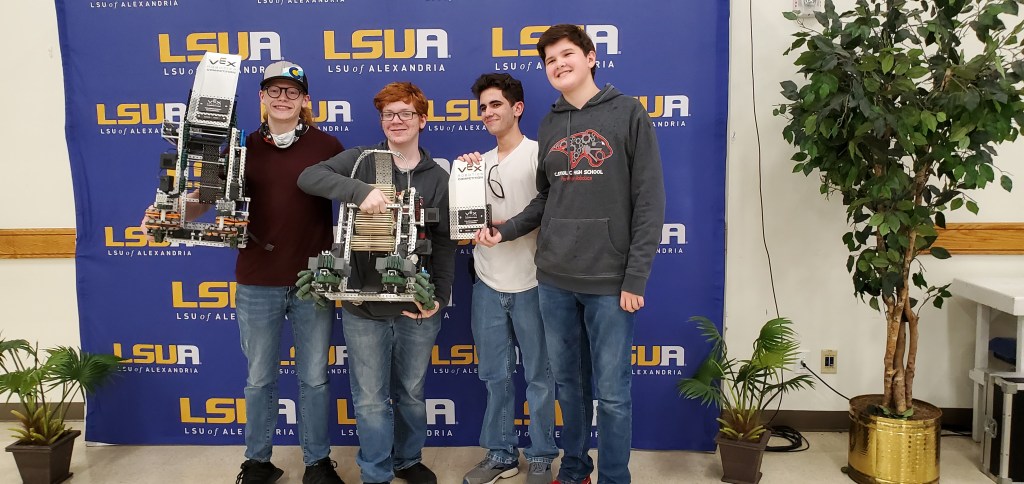Acadiana robotics clubs score big in competition.
Published 8:00 am Tuesday, July 20, 2021

- Catholic High's Panther Robotics.jpg
This summer, while some students were relaxing after an erratic school year, others were involved in extracurricular sports, like softball, baseball and soccer…oh, and robotics.
Over the past decade, there has been a push in Acadiana to provide middle and high school students an avenue into science, technology, engineering and math (STEM) education through robotics competitions. These strategy-based events have the same cheering and edge-of-the seat gameplays of any other athletic event, and even give students opportunities to earn varsity letters. And, say organizers, the rewards of robotics extend well into a student’s adult life.
This month two schools running high-performing robotics programs provide us with insight into the increasingly popular sport that is equipping students with skills for life and inspiring them to become science and technology leaders.
Lafayette: Comeaux High
In the Acadiana area, robotics was born at Ovey Comeaux High School. That’s according to Lisa Ranney, who has been a teacher and mentor of the school’s robotics program
since 2010. Team Phenomena 3616, which started at Comeaux High, now comprises 20 students (nine girls and 11 boys) from six area schools and homeschools. Phenomena 3616 was the first in Acadiana to compete in the FIRST Robotics Competition (FRC),
a program specifically for high school students. Another team, Phenomena 11200, participates in FIRST Tech Challenge (FTC), which is designed for 7th to 12th graders. FIRST (For Inspiration and Recognition of Science and Technology) is an international organization of student robotics clubs, and one of the better-known programs.
Teams of FRC – the highest level of competition in high school – are given six weeks to brainstorm, design, build (from scratch), program and test an average 120-pound robot for competition. Students are allowed to buy parts and encouraged to make specialized parts.
Before COVID the Comeaux High teams worked in a shop on campus, using limited supplies and parts. During the pandemic they moved operations to the WD and Mary Baker Smith (WDMBS) Career Center’s I-Tech Center, a robotics and manufacturing outfit that houses over $1 million of equipment and robots. There students in Lafayette Parish can program and build robots, use computers to learn 3-D design to fabricate and engineer, learn machining skills, and practice for competitions. “Students learn everything from how to solder and which screws to use, to how to problem-solve from A to Z,” says Ranney.
The club is free to join, but requires dedication to the team and to the project. Each year robotics clubs announce a theme for their annual challenge, and this year the FRC theme was INFINITE RECHARGE, in partnership with Lucasfilm as part of its Star Wars:Force for Change charity initiative. Anywhere from two to 15 adult mentors (older students and
working professionals) volunteer their time on weekday evenings and on Saturdays to provide advice and ensure that projects are carried out safely.
This year teams 3616 (FRC) and 11200 (FTC) each participated in a world-wide, virtual competition. The tasks given by the clubs are not easy, but Team 3616 has been consistently recognized for the creativity of its design and engineering. Having attended the world championship five times in 10 years, Team 3616 is currently among the top 20 in the world for innovation projects. At the end of June, the team was one of 20 schools that competed virtually in the 2021 Global Innovation Awards. Their submitted project, “Pheno-Advance 3616,” is a pedal-assist device designed to help children with leg impairments to ride a bike. Through the use of a control unit and sensors, a motor activates the bicycle pedals and provides the rotational power. (Competition results were not known at this writing.)
Other notable awards earned include FRC’s most prestigious recognition,
the Chairman’s Award for 2020 Bayou Regional and the Altice Future Innovator Awards for Excellence in Technology and Innovative Design Concept.
In 2021, in response to COVID, Team 3616 and the WDMBS Career Center began loaning out STEM activities kits – one of its many community-outreach projects. Students from 2nd through 8th grades curious about robotics can check out a kit from the Career Center for as long as a month at a time. “We had a 7-year-old boy learn to build a LEGO catapult,” says Ranney, pointing out that all you need is a passion to learn.
The FRC program is unique, in that students are expected to compete
while still upholding two foundational philosophies: “Gracious Professionalism” (remaining respectful and empathetic) and “Coopertition” (cooperating with the opposing team members, even during fierce competition). Beyond merely winning competitions, FRC’s primary objective is to be a STEM advocacy program. “Our goal is to reach students and encourage them to become interested in STEM and robotics,” says Ranney. “Students can join the teams at any point, and we don’t put a limit on who from Acadiana joins. Some of our top students have come not having any skills, but acquired them quickly.”
New Iberia: Catholic High
At CHS in New Iberia, team Panther Robotics puts their skills to the test in VEX Robotics competitions, reportedly the largest and fastest-growing program in middle and high schools. Organized in 2018 Panther Robotics is headed by coach Tabitha Erickson and consists of one middle school and three high school teams – all Catholic High students – who build robots with Lego-like pieces.
They have been working since June in preparation for VEX’s annual game in October, this one called “Tipping Point,” where the object is to have the robot pick up rings then place them on goals that are moveable. VEX games, like others, often involve the robots manipulating balls, rings, cubes and other such objects. While Panthers design their robots from scratch, they are only allowed to use standard VEX materials – a rule meant to level the playing field.
As in other robotics competitions, students are judged on skills like maneuverability, accuracy, strategy and driving (both by the student driver and when the robot moves on its own). Each student has a particular role during the two-and-a-half minute-long matches, and Erickson says the Panthers are known best for their driving skills.
This past school year, four Panther Robotics teams won five tournament championships, three excellence awards, two awards for design, three awards in robot skills, and one building award. The middle school team was state runner-up and the high school team was state champion at the 2020-2021 VEX Robotics Competition Game, receiving the robot skills award and the excellence award. Most recently, at the beginning
of June, they were a semifinalist in the Space City Regional Showcase Tournament in Houston.
Erickson says this year the team spent weekends travelling throughout the state – from Baton Rouge to Alexandria. “It’s fun, but it’s a lot of work involving hundreds of hours of their time outside of school, including meetings twice a week after school,” she says. “But if you go into it with an open mind and put your heart and soul into it, you will reap the benefits.”
Unlike other sports, competitive robotics teaches students skills, outside of teamwork, that they can use throughout their lives: time management, conflict resolution, communication, creative problem solving, stress management, resourcefulness and resilience. Studies show that robotics students have a significant advantage in the job market and that more than half of the participants go on to major in science or engineering in college.
That will be the case for Cohen Schlicher, the team’s computer programmer who joined Panther Robotics at its inception, when he was in 8th grade. “Robotics bolstered my interest in computer science,” he says. “Through my experience with robotics, I learned that I want to be deeply invested in computer science as my major in whichever university I choose to attend.”
As for Erickson, now in her third year of coaching, she says the impact robotics has on the students is more than she expected. “Introverts and extroverts with similar skills have found a place where they fit in and communicate with each other – and strategize with other teams,” she says. “They develop skills they’ll take with them the rest of their lives.”





